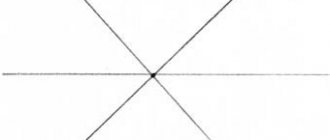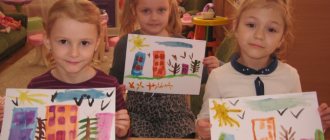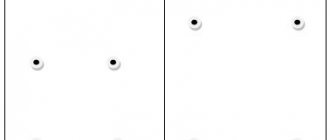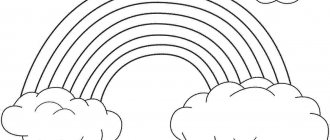On the topic: methodological developments, presentations and notes
Presentation on the world around us. Introducing children to fruit and berry trees.
Presentation on the surrounding world to familiarize children with fruit bushes.
The abstract is intended for children 2 ml. speech development groups.
Problem:Children of primary preschool age do not have sufficient understanding of plants, where they grow, the necessary conditions for their growth, and their interest in cognitive and research.
The script is recommended for young and older children.
Project objectives:1. Develop a positive attitude towards work.2. Learn to carry out individual and collective assignments.3. To consolidate children's knowledge about the structure of the bulb and the conditions necessary for growth.
Source
Summary of educational activities on drawing “Vitamin Day “Vegetables and Fruits”
Natalya Miglovets
Summary of educational activities on drawing “Vitamin Day “Vegetables and Fruits”
Summary of educational activities in drawing in the middle group on the topic Vitamin Day “ Vegetables and Fruits ”
Educational:
• consolidate children’s knowledge about vegetables and fruits (names, methods of eating)
• teach children to describe vegetables and fruits according to their characteristic features (color, shape, taste)
• improve children's tactile sensations;
• enrich children's vocabulary;
• introduce children to the concept of “ vitamins ”
, their usefulness for humans,
“microbes”
;
• improve children's ability to draw rounded shapes ;
Materials and equipment: hats with drawings of vegetables and fruits
, basket, set of models of vegetables and fruits .
Progress of the lesson:
Educator: Guys, do you know what vegetables can be collected now? (Children's answers)
That's right, in the fall a large number of very healthy vegetables : tomatoes, cucumbers, peppers, cabbage, eggplants, zucchini.
The teacher shows models of vegetables or pictures of them. Let's play with you.
Game "Find the vegetables "
Children look at the picture and name the vegetables . Then the teacher shows a picture of a vegetable garden. Children look at it and answer. Where do vegetables ? (In the garden, in the garden, underground, above ground)
.
The teacher throws the ball and names the color, and the children say what kind of vegetable there is
Cleverly hid in the garden bed
Turnips, beets and carrots (sit down and cover your eyes with your hands)
Let's get it out of the ground (imitation of the movement of pulling a carrot)
There will be lunch for the kids:
Borscht, mashed potatoes and vinaigrette. (high jumps with turns in different directions)
.
Now let's draw vegetables . I'll first show you how to
draw . vegetable stencil , place it on a sheet, then simply
I outline it with a pencil so that the outline of the vegetable that I will be
paint. Next, I take a brush, dip it in paint and use
A poke with a hard brush paints a vegetable . Now you need to draw green
(tail)
to a vegetable . I pick up green paint with my finger and draw a tail (tail)
on the vegetable . - The vegetable is ready ! Now I take a damp cloth and wipe my finger so that it is clean.
Finger gymnastics “Salad”
We peel and peel the carrots (Run the fist of the right hand over the palm of the left)
We are three or three carrots (they press their fists to their chest and make sharp movements with them back and forth)
Sprinkle it with sugar
And pour some sour cream
This is the kind of salad we have (stretch palms forward)
Rich in vitamins (Stroke with palm forward)
And now you will draw each of your vegetables .
- Let's see what vegetables you drew and what you got. U
you have a whole garden of vegetables . They are all so different, beautiful, bright,
Summary of the lesson on unconventional drawing “My Favorite Bear” in the second junior group Dear colleagues, I bring to your attention part of the lesson on unconventional drawing “My Favorite Bear”. My students really like it. Summary of a lesson on moral and patriotic development “My Favorite City” in the middle group Goal: to cultivate in children a sense of love for their small Motherland, their hometown Tasks: to clarify information about their hometown with children, to activate it. Summary of the lesson on drawing “Butterflies” in the middle group Hello dear colleagues! I bring to your attention a summary of a lesson in the middle group on unconventional drawing: klyasography, etc.
Summary of the drawing lesson “Favorite cartoon character about dinosaurs” in the middle group Goal: learn to draw familiar images of cartoon characters Objectives: develop artistic skills; improve your ability to draw images.
Summary of the drawing lesson for February 23 “Daddy, my beloved!” with children of the preparatory group Integration of OO: “Socio-communicative development”, “Cognitive development”, “Speech development”, “Artistic and aesthetic development”.
Source
DRAWING. “WHAT’S RIPE IN THE GARDEN”
Software tasks.
Learn to convey the shape, color and characteristic features of vegetables in a drawing; work on the composition of the drawing - evenly place objects throughout the entire sheet of paper, leaving a little free space between them, find a value for objects that corresponds to the size of a given sheet of paper; paint objects according to shape with wide, rounded lines, holding the brush flat.
Material.
The teacher has object pictures with images of vegetables: tomatoes, cucumbers, carrots, turnips, beets, radishes, eggplant, onions; three pictures - vegetables are drawn on a circle, two of them have an incorrect composition (on one the vegetables are too small and located far from each other, on the other - the opposite).
Progress of the lesson.
The teacher places object pictures with images of different vegetables on the board. Invites children to name the shape and color of the vegetable (this is an orange long carrot, this is a round red tomato, this is a round dark red beet, etc.).
—Where do people grow vegetables? (In the gardens.) Today everyone will draw on a round plate four or five vegetables that they want, but in such a way that everyone can understand by their shape and color what kind of vegetables they are.
- Now I will show you three drawings. Two of them were drawn by Dunno, and one by another cheerful little man - Pencil. And you guess which drawings are from Dunno and which are from Pencil.
Places these drawings in front of the children. After the children answer, he asks which drawing they liked best and why. After all, in all the pictures the vegetables are well drawn. Why didn’t the kids like Dunno’s drawings? Confirms: for the drawing to turn out beautiful, it is important to place the objects correctly on a sheet of paper. It is ugly if small objects are drawn on a large sheet, and even far from each other. It is also ugly if the objects are large and drawn close to each other and there is no free space between them. It is best when the items are located throughout the entire sheet of paper, close to each other and there is free space between them. Just like Pencil drew.
Next, you should remind the children that they will not paint over the vegetables in straight, wide stripes, but according to their shape, i.e. repeat the shape of the vegetable. The cucumber is oval in shape, and you need to paint it with elongated arcs (you can show it if the children have forgotten this technique). Beets are round, and you need to paint them with semicircular wide lines, holding the brush flat. With this type of painting, children do not go beyond the outline of the drawing.
Having finished the announcements, the teacher asks the children to choose vegetables and place them beautifully on the plate. Try to make their drawings look like Pencil's drawing. Removes teaching aids.
During the drawing process, the teacher advises to depict, using the tip of the brush, the petioles, sepals of vegetables, and the remains of tops of carrots and beets.
At the end of the lesson, you can invite the children to look at each other’s drawings and point out those in which the vegetables are different in color and shape. Mark those works that depict vegetables that are not in the other drawings, for example, eggplant, etc. Then again display the “drawing” of the Pencil and offer to place next to it those works in which the vegetables are located just as beautifully (across the entire sheet, not far from each other from a friend, there is free space between the vegetables). This technique develops self-analysis skills in children.
LESSON 6
DRAWING. "WHAT'S RIPE IN THE GARDEN"
Software tasks.
Learn to convey in a drawing the characteristic shape and color of familiar fruits growing in our gardens and in the south; continue to develop compositional skills (arranging objects evenly across the entire sheet of paper); develop the ability to work on a plan (in advance, before starting work, mentally imagine the content of your drawing); continue to develop the skills of shading with a pencil: in one direction with continuous movements without skipping, without going beyond the contour, with uniform moderate pressure.
Material.
The teacher has object pictures with images of fruits: apple, pear, plum, cherry, orange, lemon, banana, pomegranate, grapes; a sheet of paper in the form of a circle on which an orange, pomegranate, and a bunch of grapes are outlined in colored pencils (orange, red, purple or blue); manual from lesson 5 with different compositions of vegetables. Children have sheets of paper in the form of a circle with a diameter of 16-18 cm, boxes with colored pencils of 12-18 colors.
Progress of the lesson.
Place in front of the children object pictures with images of fruits, divided into two groups.
Invite children to name the fruits located in the top row (apple, pear, cherry, plum), then name the fruits from the bottom row (lemon, orange, pomegranate, banana, grapes). Say: “Children, guess why I divided the fruits into two groups.” Listen to the answers and confirm the one where the sign of the grouping of fruits is named - the place where they grow. To say that some fruits grow well in our climate, others can only grow in the south, since they require more heat and more sunny days to ripen than in our area. Southern fruits are brought to us by plane, in cars and in refrigerator cars and refrigerators.
Show the children a round sheet of paper and explain: “Today you will draw fruits on plates. Whoever wants, will draw a few southern fruits, and whoever wants, will depict the fruits growing in our gardens. To make your drawings beautiful, remember how to arrange objects on a sheet of paper. Not the way Dunno did it, but the way Pencil arranged the vegetables (list the manuals from lesson 5). Look at my riddle drawing and guess what fruits I decided to draw. My drawing shows only the outlines of the fruit in the color I paint them.”
After the children answer that the contours of southern fruits are drawn: an orange - with an orange pencil, a pomegranate - with a red pencil, a bunch of grapes - with a purple pencil, say: “I also suggest that you do not immediately draw each fruit completely, but depict what you have planned in outline. And I will guess from your contours what kind of fruit you will draw. Think, decide and start drawing."
Work on the coloring technique during the lesson with those children who need it. Show painting techniques with an explanation of the rules in your riddle drawing. When children draw outlines of fruits, pay attention to conveying their shape (“I can’t guess – is this yellow outline a pear or a lemon?”). If necessary, draw children's attention to the shape of a particular fruit shown in the picture. Pay special attention to the arrangement of the fruit on the plate. Using their contours, “guess” the content of the drawing.
At the end of the lesson, invite the children to place plates with southern fruits on the top shelf of the board, and plates with fruits that grow here on the bottom shelf. Or arrange the drawings in two rows on the table. You can play up looking at children's drawings - organize a game at a sales exhibition or in a cafe. Through game situations, highlight drawings with a beautiful arrangement of fruits on plates, with fruits of various colors.
LESSON 7
GCD drawing lesson in the middle group “Vegetables on a plate”
Tatiana Shashina
GCD drawing lesson in the middle group “Vegetables on a plate”
Municipal preschool educational institution
kindergarten No. 16 “Rodnichok”
Pavlovsky Posad urban district, Moscow region
142500, Moscow region, Pavlovsky Posad, lane. Herzen, house 34
GCD drawing lesson
in the middle group
«Vegetables on a plate»
Goals: Learn to depict round and oval objects, develop the ability to change the direction of movement along one arc to another; convey the differences between oval and round objects; arrange objects evenly on a sheet of paper; consolidate techniques for painting objects with paints. develop the ability to work with paints, thoroughly rinse brushes when changing paints; cultivate neatness.
Equipment: Circle ( plate , for each child; brushes; jar of water, vegetables or their dummies , paints, brushes, napkins.
Preliminary preparation: conversations with children about the benefits of vegetables , finding out what vegetables they like to eat , how and where vegetables ; reading riddles about vegetables .
Summary of GCD in the middle group of kindergarten on the topic “Vegetables”
Direct educational activities for children 4-5 years old on the topic “Vegetables”
Program objectives: 1. Consolidate and clarify children’s knowledge about vegetables; 2. Continue to develop the ability to solve riddles; 3. Develop speech activity and attention; 4. Develop the ability to distinguish vegetables by touch and taste; 5. Practice selecting adjectives; 6. Cultivate diligence when completing tasks.
Material:
• Vegetables; • Dummy vegetables; • Opaque pouch; • Pictures for coloring “vegetables”;
• Pencils, felt-tip pens.
Progress of the lesson:
Educator: I’ll start our lesson today with riddles. In order to guess them, you need to listen to them carefully. You are ready? Children: Yes
Puzzles
I spent the whole summer trying - Dressing, dressing... And when autumn approached, She gave us our clothes. We put a hundred clothes in a barrel. – cabbage – I dragged the fox out of his mink by his curly tuft. It feels very smooth to the touch, it tastes like sweet sugar. – carrots – Doesn’t upset anyone, but makes everyone cry. - onion - There is a yellow ball in the garden, But it doesn’t run at a gallop, It’s like the full moon, The seeds in it are delicious. – pumpkin – How riddles grew in our garden bed, Juicy and large, So round. They turn green in summer, and turn red in autumn. tomatoes Our piglets grew up in the garden, sideways towards the sun, crocheted tails. These piglets play hide and seek with us... Cucumbers If you want a vinaigrette, go to the garden for it, It has a beautiful color Both outside and inside! Beetroot It can be very different - Green, yellow, red, It’s both hot and sweet. It’s worth knowing its habits. Pepper
Educator : Well done! You are all very attentive and smart. They guessed carrots, cabbage, onions, and peppers. How can all this be called in one word?
Children: Vegetables. Educator: Correct. That's what we'll talk about today. “Vegetables” is the topic of our lesson today.
Conversation
Educator: How many of you know the difference between vegetables and fruits? Children's answers
Educator: Where do vegetables grow? Children: Vegetables grow in the garden, in the garden Educator : What is the name of the profession of a person who grows vegetables? Children: Vegetable grower Educator : What are vegetables for? Children: Vegetables are needed to be eaten. Educator : What can be prepared from vegetables? Children : Salad, borscht, cabbage soup, fry, eat raw, etc.
There are vegetables (or dummies) on the table
The game "What's missing?"
Children close their eyes. The teacher removes one of the vegetables, the children open their eyes and answer what is missing.
Game "Wonderful bag"
The teacher puts dummies of vegetables into an opaque bag. Children take turns identifying vegetables by touch.
Educator : Well done! How many of you like to eat vegetables?
Children's answers Educator : Guys, vegetables are very healthy, they contain a lot of vitamins. You definitely need to eat them. But before you eat them, you need to do a very important thing. Which? Children : Wash them Teacher : Correct.
Game "Guess the taste"
Educator : I washed all the vegetables and I want to treat you to them. But not just to treat, but so that you can guess the taste of the vegetable. To do this you need to close your eyes. The teacher gives the children a small piece of vegetable, the children guess.
!!!
Note: The teacher must know for sure whether children are allergic to certain vegetables.
Educator : Okay, you completed the task. As you have already noticed, vegetables have different tastes, colors, and touches. Choose a suitable description for each vegetable.
Game “Which vegetable?”
Children are shown pictures of vegetables and asked to characterize them:
Onion – bitter, white, aromatic, round; Carrots are orange, long, sweet, tasty, healthy, etc.
Educator : Now you know everything about vegetables, their taste, color and shape. I suggest sitting down at the tables and coloring the pictures.
Abstract of direct educational activities for children of the middle group. Abstract of educational activities for mathematical development in the middle group. Crossword puzzle with answers for children 6-7 years old. Vegetables Synopsis of a cognitive lesson on the topic “Vegetables”. Second junior group
Riddles about vegetables for children 6-7 years old with answers
Poems about vegetables and fruits for children 5-7 years old
Source: https://ped-kopilka.ru/blogs/blog42589/neposredstveno-obrazovatelnaja-dejatelnost-dlja-detei-4-5-let-na-temu-ovoschi.html
Summary of a drawing lesson for the middle group “Garden and vegetable garden”
Anna Shnurova
Summary of a drawing lesson for the middle group “Garden and vegetable garden”
Summary of direct educational activities
On artistic and aesthetic development ( drawing )
for middle group
on the topic: "Garden and vegetable garden "
teacher of municipal educational institution "Yaninskaya Secondary School"
DO No. 2 Shnurova A.V.
Materials: pencil, eraser, paints, brush, album, water bottle.
Goal: Continue to introduce children to the garden and vegetable garden .
Task: to develop the ability to use nouns with a general meaning (fruits, vegetables)
;
cultivate a desire to work in the garden and vegetable garden .
Equipment: “magic bag”
.
Materials: pencil, eraser, paints, brush, album, water bottle.
Notes on drawing "Color the vegetables"
Vera Khlyntseva
Notes on drawing "Color the vegetables"
Summary of GCD for drawing on the topic : “ Color the vegetables ”
— clarify children’s knowledge about vegetables ;
— to develop graphic skills: learns to hold a pencil correctly, draw lines without lifting them from the paper, hatch in one direction without going beyond the contours;
— develop fine motor skills, the ability to make precise movements of the fingers while working with cereals;
— cultivate perseverance and attentiveness in class.
- images of vegetables ;
— printed assignments;
- vegetable ;





